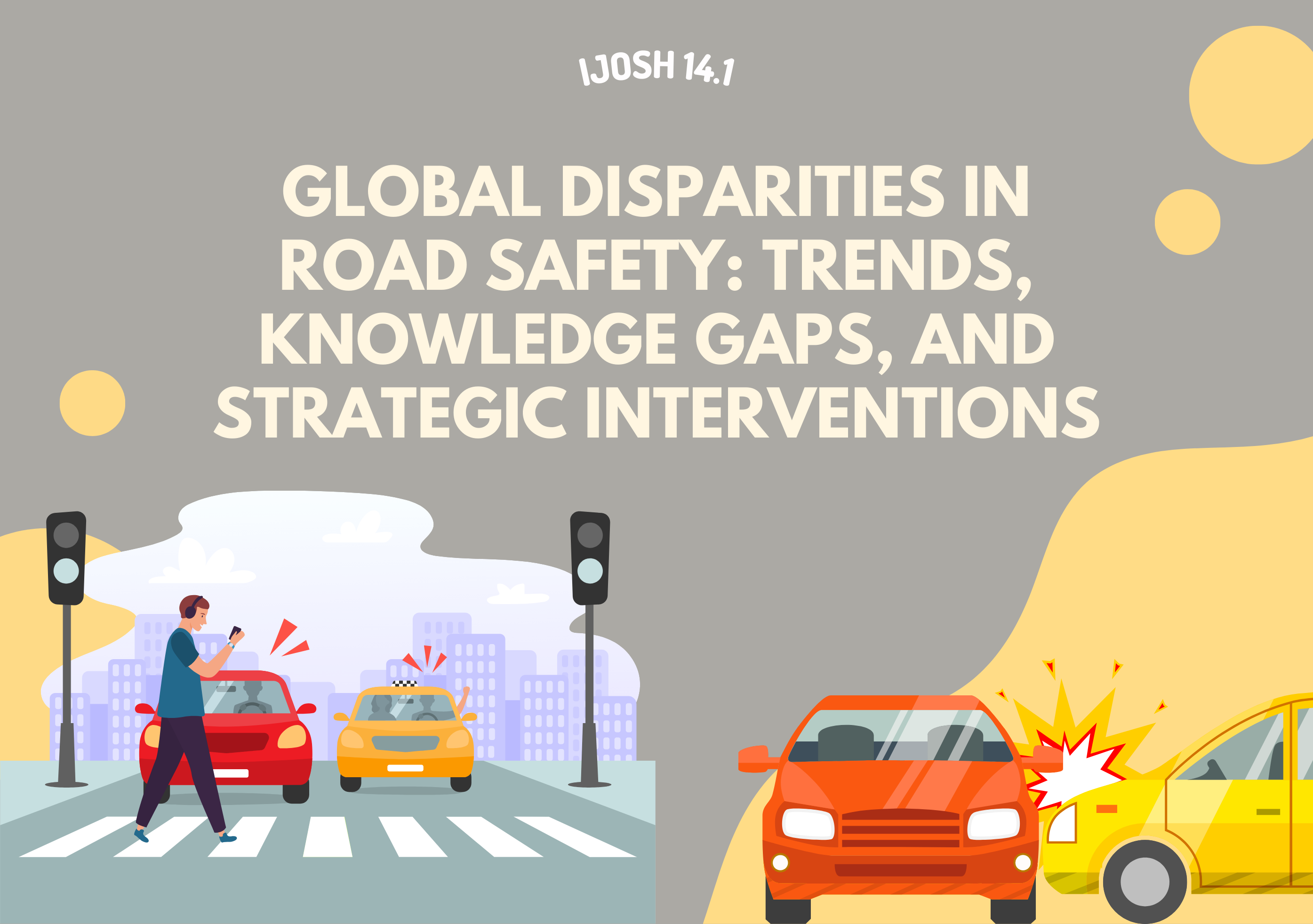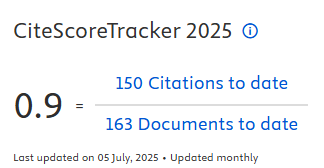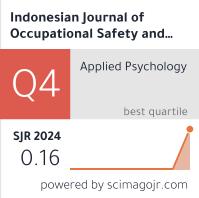Global Disparities in Road Safety: Trends, Knowledge Gaps, and Strategic Intervention

Downloads
Introduction: Traffic accidents remain a pressing global issue, disproportionately affecting low- and middle-income countries (LMICs) with higher mortality rates, socio-economic burdens, and persistent policy implementation challenges. This study conducts a bibliometric analysis to identify global trends, conceptual developments, and critical knowledge gaps in road safety research, with a focus on LMIC contexts. Methods: A total of 402 peer-reviewed journal articles published between 2014 and 2025 were retrieved from the Scopus database. Bibliometric coupling and co-word analysis were conducted using VOSviewer to explore research dynamics. Results: The analysis identified five thematic clusters: (1) gamification and technology integration, (2) behavioral insights and interventions, (3) risk perception and training, (4) equity and infrastructure design, and (5) cyclist crash risk mitigation. Global trends show increasing attention to digital tools such as virtual reality, machine learning, and simulation-based training. Conceptual developments include integrating behavioral science into traffic safety and designing inclusive infrastructure. However, critical gaps persist, particularly the limited representation of LMICs in the literature, lack of contextual adaptation, and minimal real-world validation of technological solutions. Conclusion: This study underscores the need for a multidimensional approach that unites technology, human behavior, and infrastructure improvements. Strengthening research in LMICs, validating emerging tools in real-life scenarios, and fostering cross-sectoral collaborations are key to reducing global traffic injuries and fatalities through evidence-informed policies.
Agarwala, R. and Vasudevan, V. (2023) ‘Role of High-Speed Roads and Vehicle Ownership on Traffic Fatalities in India’, Transportation Research Record: Journal of the Transportation Research Board, 2677(1), pp. 1461–1472. Available at: https://doi.org/10.1177/03611981221104803.
Aghdam, F.B. et al. (2020) ‘Developing a National Road Traffic Safety Education Program in Iran’, BMC Public Health, 20(1). Available at: https://doi.org/10.1186/s12889-020-09142-1.
Alonso, F. et al. (2017) ‘Knowledge, Perceived Effectiveness and Qualification of Traffic Rules, Police Supervision, Sanctions and Justice’, Cogent Social Sciences, 3(1). Available at: https://doi.org/10.1080/23311886.2017.1393855.
Amin, M.A.M. et al. (2024) ‘Bibliometric Analysis of the Use of Electrospun Chitosan Nanofibers in Biomedical Applications’, Journal of Sustainable Materials Processing and Management, 4(1). Available at: https://doi.org/10.30880/jsmpm.2024.04.01.001.
Andarini, D., Camelia, A. and Ibrahim, M.M. (2021) ‘Factors Related to Road Accidents in Palembang, South Sumatera, Indonesia’, International Journal of Public Health Science (IJPHS), 10(3), p. 638. Available at: https://doi.org/10.11591/ijphs.v10i3.20768.
von Beesten, S. and Bresges, A. (2022) ‘Effectiveness of Road Safety Prevention in Schools’, Frontiers in Psychology, 13. Available at: https://doi.org/10.3389/fpsyg.2022.1046403.
Bohdidi, Z. et al. (2024) ‘Enhancing Road Safety Decision-Making through Analysis of Youth Survey Data: A Descriptive Statistical Approach’, Safety, 10(2), p. 45. Available at: https://doi.org/10.3390/safety10020045.
Cassarino, M. and Murphy, G. (2018) ‘Reducing Young Drivers’ Crash Risk: Are We there Yet? An Ecological Systems-based Review of the Last Decade of Research’, Transportation Research Part F: Traffic Psychology and Behaviour, 56, pp. 54–73. Available at: https://doi.org/10.1016/j.trf.2018.04.003.
Champahom, T. et al. (2022) ‘Factors Affecting Severity of Motorcycle Accidents on Thailand’s Arterial Roads: Multiple Correspondence Analysis and Ordered Logistics Regression Approaches’, IATSS Research, 46(1), pp. 101–111. Available at: https://doi.org/10.1016/j.iatssr.2021.10.006.
Chen, Y. et al. (2022) ‘Underestimated Risk Perception Characteristics of Drivers Based on Extended Theory of Planned Behavior’, International Journal of Environmental Research and Public Health, 19(5), p. 2744. Available at: https://doi.org/10.3390/ijerph19052744.
Chou, C.-C. et al. (2022) ‘Effectiveness Evaluation on Cross-sector Collaborative Education Programs for Traffic Safety toward Sustainable Motorcycle Culture in Vietnam’, IATSS Research, 46(2), pp. 258–268. Available at: https://doi.org/10.1016/j.iatssr.2022.01.001.
Corsi, S. et al. (2022) ‘A Bibliometric Analysis of the Scientific Literature on Biostimulants’, Agronomy, 12(6), p. 1257. Available at: https://doi.org/10.3390/agronomy12061257.
Cox, D.J. et al. (2017) ‘Can Youth with Autism Spectrum Disorder Use Virtual Reality Driving Simulation Training to Evaluate and Improve Driving Performance? An Exploratory Study’, Journal of Autism and Developmental Disorders, 47(8), pp. 2544–2555. Available at: https://doi.org/10.1007/s10803-017-3164-7.
Donthu, N. et al. (2021) ‘How to Conduct a Bibliometric Analysis: An Overview and Guidelines’, Journal of Business Research, 133, pp. 285–296. Available at: https://doi.org/10.1016/j.jbusres.2021.04.070.
Faus, M. et al. (2021) ‘Are Traffic Announcements Really Effective? A Systematic Review of Evaluations of Crash-Prevention Communication Campaigns’, Safety, 7(4), p. 66. Available at: https://doi.org/10.3390/safety7040066.
Faus, M. et al. (2022) ‘Are Adult Driver Education Programs Effective? A Systematic Review of Evaluations of Accident Prevention Training Courses’, International Journal of Educational Psychology, 12(1), pp. 62–91. Available at: https://doi.org/10.17583/ijep.8805.
Fauzi, M.A. (2023) ‘Knowledge Sharing in Health Community of Practice (CoP) and Online Health Communities (OHCs): A Bibliometric Analysis’, Journal of Information & Knowledge Management, 22(03). Available at: https://doi.org/10.1142/S0219649223500065.
Gasana, J. et al. (2022) ‘Risky Roads in Kuwait: An Uneven Toll on Migrant Workers’, International Journal of Environmental Research and Public Health, 19(15), p. 9726. Available at: https://doi.org/10.3390/ijerph19159726.
Goel, R. et al. (2024) ‘Effectiveness of Road Safety Interventions: An Evidence and Gap Map’, Campbell Systematic Reviews, 20(1). Available at: https://doi.org/10.1002/cl2.1367.
Gounaridou, A., Siamtanidou, E. and Dimoulas, C. (2021) ‘A Serious Game for Mediated Education on Traffic behavior and Safety Awareness’, Education Sciences, 11(3). Available at: https://doi.org/10.3390/educsci11030127.
Haghani, M. et al. (2022) ‘Road Safety Research in the Context of Low- and Middle-income Countries: Macro-scale Literature Analyses, Trends, Knowledge Gaps and Challenges’, Safety Science, 146(October 2021), p. 105513. Available at: https://doi.org/10.1016/j.ssci.2021.105513.
He, Y. et al. (2022) ‘Visualization and Analysis of Global Vision Zero Studies and Policy Orientation in China’, International Journal of Environmental Research and Public Health, 19(22), p. 14841. Available at: https://doi.org/10.3390/ijerph192214841.
Hizkel, A. et al. (2021) ‘Outcome and Associated Factors Among Road Traffic Accident Victims at Wolaita Soddo Christian Hospital, Wolaita Soddo, South Ethiopia 2020, Institution-Based Cross-Sectional Study’. Available at: https://doi.org/10.1101/2021.09.16.21262878.
Hossain, M.M. et al. (2022) ‘Cellphone-distracted Crashes of Novice Teen Drivers: Understanding Associations of Contributing Factors for Crash Severity Levels and Cellphone usage Types’, Traffic Injury Prevention, 23(7), pp. 390–397. Available at: https://doi.org/10.1080/15389588.2022.2097667.
Hughes, B.P., Anund, A. and Falkmer, T. (2016) ‘A Comprehensive Conceptual Framework for Road Safety Strategies’, Accident Analysis & Prevention, 90, pp. 13–28. Available at: https://doi.org/10.1016/j.aap.2016.01.017.
Khan, N. et al. (2021a) ‘An Adaptive Game-Based Learning Strategy for Children Road Safety Education and Practice in Virtual Space’, Sensors, 21(11), p. 3661. Available at: https://doi.org/10.3390/s21113661.
Kirytopoulos, K. et al. (2024) ‘A Virtual Reality Instrument to Raise Drivers’ Awareness on Safer Driving through Road Tunnels’, Proceedings of the Institution of Mechanical Engineers, Part O: Journal of Risk and Reliability, 238(3), pp. 451–463. Available at: https://doi.org/10.1177/1748006X231175719.
Koloushani, M. et al. (2022) ‘The Analysis of Spatial Patterns and Significant Factors Associated with Young-Driver-Involved Crashes in Florida’, Sustainability, 14(2), p. 696. Available at: https://doi.org/10.3390/su14020696.
Kourmousi, N. et al. (2024) ‘Evaluation of the Road Safety Education “E-drive Academy” Interactive Program in Greek Elementary Schools: A Study of 834 Fourth Grade Students’, Journal of Road Safety, 35(1), pp. 27–39. Available at: https://doi.org/10.33492/JRS-D-24-1-2117050.
Krasniuk, S. et al. (2024) ‘The Effectiveness of Driving Simulator Training on Driving Skills and Safety in Young Novice Drivers: A Systematic Review of Interventions’, Journal of Safety Research, 91(March), pp. 20–37. Available at: https://doi.org/10.1016/j.jsr.2024.08.002.
Krithika P., Shanmugam V. and Kiruba, A.S. (2023) ‘Emerging Patterns of E-Commerce Apparel Attributes: A Bibliometric Analysis’, Quality - Access to Success, 24(194). Available at: https://doi.org/10.47750/QAS/24.194.46.
Kwon, J.-H. et al. (2022) ‘Pedestrians Safety Perception and Crossing Behaviors in Narrow Urban Streets: An Experimental Study using Immersive Virtual Reality Technology’, Accident Analysis & Prevention, 174(April), p. 106757. Available at: https://doi.org/10.1016/j.aap.2022.106757.
Lijarcio, I. et al. (2022) ‘Assessing Risk Perception over Recidivist Traffic Offenders from a Multi-group Approach: How Gendered Could It Be?’, The European Journal of Psychology Applied to Legal Context, 14(1), pp. 33–41. Available at: https://doi.org/10.5093/ejpalc2022a4.
Liu, Mingyue et al. (2024) ‘Global Research Hotspots and Trends of Theta Burst Stimulation from 2004 to 2023: A Bibliometric Analysis’, Frontiers in Neurology, 15. Available at: https://doi.org/10.3389/fneur.2024.1469877.
McIlroy, R.C. et al. (2022) ‘The Influence of Fatalistic Beliefs and Risk Perceptions on Road Safety Attitudes in Latin America; A Two-Country Study’, Transportation Research Part F: Traffic Psychology and Behaviour, 90(July), pp. 84–99. Available at: https://doi.org/10.1016/j.trf.2022.08.003.
Meir, A., Oron-Gilad, T. and Parmet, Y. (2015a) ‘Are Child-Pedestrians Able to Identify Hazardous Traffic Situations? Measuring Their Abilities in A Virtual Reality Environment’, Safety Science, 80, pp. 33–40. Available at: https://doi.org/10.1016/j.ssci.2015.07.007.
Meir, A., Oron-Gilad, T. and Parmet, Y. (2015b) ‘Can Child-Pedestrians’ Hazard Perception Skills be Enhanced?’, Accident Analysis and Prevention, 83, pp. 101–110. Available at: https://doi.org/10.1016/j.aap.2015.07.006.
Mokhtarpour, R. and Khasseh, A.A. (2021) ‘Twenty-Six Years of LIS Research Focus and Hot Spots, 1990–2016: A co-word analysis’, Journal of Information Science, 47(6), pp. 794–808. Available at: https://doi.org/10.1177/0165551520932119.
Möller, H. et al. (2022) ‘Driving Offences and Risk of Subsequent Crash in Novice Drivers: the Drive Cohort Study 12-Year Follow-up’, Injury Prevention, 28(5), pp. 396–404. Available at: https://doi.org/10.1136/injuryprev-2021-044482.
Nguyen-Phuoc, D.Q. et al. (2019) ‘Exploring the Prevalence and Factors Associated with Self-reported Traffic Crashes among App-based Motorcycle Taxis in Vietnam’, Transport Policy, 81, pp. 68–74. Available at: https://doi.org/10.1016/j.tranpol.2019.06.006.
Pervez, A. (2024) ‘Navigating the Road to Safer Travel in Pakistan: A Multi-Perspective Analysis of Road Safety Challenges and Solutions’, Research Journal of Engineering & Technology, 13(2). Available at: https://doi.org/10.33317/ssurj.591.
Regmi, M. (2021) ‘What does it Take to Improve Road Safety in Asia?’, Journal of Road Safety, 32(4), pp. 29–39. Available at: https://doi.org/10.33492/JRS-D-21-00040.
Rojas-Lamorena, Á.J., Del Barrio-García, S. and Alcántara-Pilar, J.M. (2022) ‘A Review of Three Decades of Academic Research on Brand Equity: A Bibliometric Approach using Co-word Analysis and Bibliographic Coupling’, Journal of Business Research, 139, pp. 1067–1083. Available at: https://doi.org/10.1016/j.jbusres.2021.10.025.
Sabeti, S., Ardecani, F.B. and Shoghli, O. (2024) ‘Augmented Reality Warnings in Roadway Work Zones: Evaluating the Effect of Modality on Worker Reaction Times’, Computer science, pp. 1–16. Available at: https://doi.org/https://doi.org/10.48550/arXiv.2403.15571.
Sari, N., Malkhamah, S. and Budi, S. (2024) ‘Road Traffic Accidents Factor on Rural Arterial Roads’, Journal of Applied Engineering Science, 22(2), pp. 470–482. Available at: https://doi.org/10.5937/jaes0-49183.
Sayed, I., Abdelgawad, H. and Said, D. (2022) ‘Studying Driving Behavior and Risk Perception: A Road Safety Perspective in Egypt’, Journal of Engineering and Applied Science, 69(1), p. 22. Available at: https://doi.org/10.1186/s44147-021-00059-z.
Schneider, S. and Bengler, K. (2020) ‘Virtually the Same? Analysing Pedestrian Behaviour by Means of Virtual Reality’, Transportation Research Part F: Traffic Psychology and Behaviour, 68, pp. 231–256. Available at: https://doi.org/10.1016/j.trf.2019.11.005.
Setyowati, D.L. et al. (2024a) ‘Assessment of Risky Riding Behaviors Using the Motorcycle Rider Behavior Questionnaire (MRBQ) among University Students’, The Open Public Health Journal, 17(1), pp. 1–9. Available at: https://doi.org/10.2174/0118749445281252240316204804.
Setyowati, D.L. et al. (2024b) ‘The Relationship Between Driving Behavior and Road Safety Education Concerning Road Traffic Accidents Among Young Drivers: A Scoping Review’, Malaysian Journal of Medicine and Health Sciences, 20, pp. 155–162.
Setyowati, D.L. et al. (2025) ‘Understanding Risk Factors in Road Traffic Accidents among Young Motorcyclists Aged 18-24: A Scoping Review’, Journal of Public Health and Development, 23(1), pp. 311–328. Available at: https://doi.org/10.55131/jphd/2025/230123.
Smith, S.S. et al. (2024) ‘Reducing Crash Risk for Young Drivers: Protocol for a Pragmatic Randomised Controlled Trial to Improve Young Driver Sleep’, Heliyon, 10(5), p. e27066. Available at: https://doi.org/10.1016/j.heliyon.2024.e27066.
Sovacool, B.K. (2017) ‘Experts, Theories, and Electric Mobility Transitions: Toward an Integrated Conceptual Framework for the Adoption of Electric Vehicles’, Energy Research and Social Science, 27, pp. 78–95. Available at: https://doi.org/10.1016/j.erss.2017.02.014.
Stelling-Konczak, A. et al. (2017) ‘Mobile Phone Conversations, Listening to Music and Quiet (Electric) Cars: Are Traffic Sounds Important for Safe Cycling?’, Accident Analysis and Prevention, 106(November 2016), pp. 10–22. Available at: https://doi.org/10.1016/j.aap.2017.05.014.
Stoker, P. et al. (2015) ‘Pedestrian Safety and the Built Environment: A Review of the Risk Factors’, Journal of Planning Literature, 30(4), pp. 377–392. Available at: https://doi.org/10.1177/0885412215595438.
Tiwari, R.R. et al. (2021) ‘Road Use Pattern and Street Crossing Habits of Schoolchildren in India’, Frontiers in Public Health, 9. Available at: https://doi.org/10.3389/fpubh.2021.628147.
Torbaghan, M. E. et al. (2022) ‘Understanding the Potential of Emerging Digital Technologies for Improving Road Safety’, Accident Analysis & Prevention, 166(June 2021), p. 106543. Available at: https://doi.org/10.1016/j.aap.2021.106543.
Useche, S. et al. (2018) ‘Infrastructural and Human Factors Affecting Safety Outcomes of Cyclists’, Sustainability (Switzerland), 10(2). Available at: https://doi.org/10.3390/su10020299.
Useche, S.A. et al. (2018) ‘Distraction of Cyclists: How does it Influence Their Risky Behaviors and Traffic Crashes?’, PeerJ, 2018(9), pp. 1-25. Available at: https://doi.org/10.7717/peerj.5616.
Useche, S.A. et al. (2019) ‘Explaining Self-reported Traffic Crashes of Cyclists: An Empirical Study based on Age and Road Risky Behaviors’, Safety Science, 113, pp. 105–114. Available at: https://doi.org/https://doi.org/10.1016/j.ssci.2018.11.021.
Useche, S.A. et al. (2022) ‘Unsafety on Two Wheels, or Social Prejudice? Proxying Behavioral Reports on Bicycle and E-scooter Riding Safety – A mixed-methods Study’, Transportation Research Part F: Traffic Psychology and Behaviour, 89(October 2021), pp. 168–182. Available at: https://doi.org/10.1016/j.trf.2022.06.015.
Varghese, N. et al. (2023) ‘Interplay between Stress, Aleep, and BDNF in a High-risk Sample of Young Adults’, Scientific Reports, 13(1), p. 20524. Available at: https://doi.org/10.1038/s41598-023-47726-0.
Virani, S. and Rautela, S. (2025) ‘Metaverse and Education: Identifying Key Themes and Future Research Trajectories’, The International Journal of Information and Learning Technology, 42(1), pp. 84–106. Available at: https://doi.org/10.1108/IJILT-05-2024-0083.
Wang, C. et al. (2020) ‘Exploring Factors Influencing the Risky Cycling Behaviors of Young Cyclists Aged 15–24 Years: A Questionnaire-Based Study in China’, Risk Analysis, 40(8), pp. 1554–1570. Available at: https://doi.org/10.1111/risa.13499.
Wang, R. et al. (2024) ‘Bibliometric Analysis of the Application of Deep Learning in Cancer from 2015 to 2023’, Cancer Imaging, 24(1), p. 85. Available at: https://doi.org/10.1186/s40644-024-00737-0.
Yan, M. et al. (2021) ‘Characteristics and Causes of Particularly Major Road Traffic Accidents Involving Commercial Vehicles in China’, International Journal of Environmental Research and Public Health, 18(8), p. 3878. Available at: https://doi.org/10.3390/ijerph18083878.
Zahid, M. et al. (2020) ‘Predicting risky and aggressive driving behavior among taxi drivers: Do spatio-temporal attributes matter?’, International Journal of Environmental Research and Public Health, 17(11), pp. 1–21. Available at: https://doi.org/10.3390/ijerph17113937.
Zainuldin, M.H. and Lui, T.K. (2021) ‘A Bibliometric Analysis of CSR in the Banking Industry: A Decade Study Based on Scopus Scientific Mapping’, The International Journal of Bank Marketing, 40(1), pp. 1–26. Available at: https://doi.org/10.1108/ijbm-04-2020-0178.
Zamani, N. (2024) ‘The Use of Social Media Augmented Reality for Engaging Parents and Educating Children About Road Safety’, Journal of Road Safety, 35(1), pp. 65–74. Available at: https://doi.org/10.33492/JRS-D-24-1-2123565.
Zhong, S. et al. (2024) ‘Artificial Intelligence Applications in Bone Fractures: A Bibliometric and Science Mapping Analysis’, Digital Health, 10. Available at: https://doi.org/10.1177/20552076241279238.

This work is licensed under a Creative Commons Attribution-NonCommercial-ShareAlike 4.0 International License.

In order to be accepted and published by The Indonesian Journal of Occupational Safety and Health, Author(s) who submit an article should complete all the review process. The copyright of received articles assigned to the The Indonesian Journal of Occupational Safety and Health and Department of Safety and Health, Universitas Airlangga as publishers of the journal. The intended copyright includes the rights to publish articles in various forms (including reprints).
The Editorial Team of The Indonesian Journal Of Occupational Safety and Health and Department of Safety and Health strive to ensure that no errors occur in the articles that have been published, both data errors and statements in the article.
Users of this website will be licensed to use materials from this website following the Creative Commons Attribution-NonCommercial-ShareAlike 4.0 International License. No fees charged. Please use the materials accordingly.
------------------------------------------------------------------------------------------------------------------------------------------------------------------------------------------
Attribution ” You must give appropriate credit, provide a link to the license, and indicate if changes were made. You may do so in any reasonable manner, but not in any way that suggests the licensor endorses you or your use.
NonCommercial ” You may not use the material for commercial purposes.
ShareAlike ” If you remix, transform, or build upon the material, you must distribute your contributions under the same license as the original.







 How to Submit Articles in OJS
How to Submit Articles in OJS

























